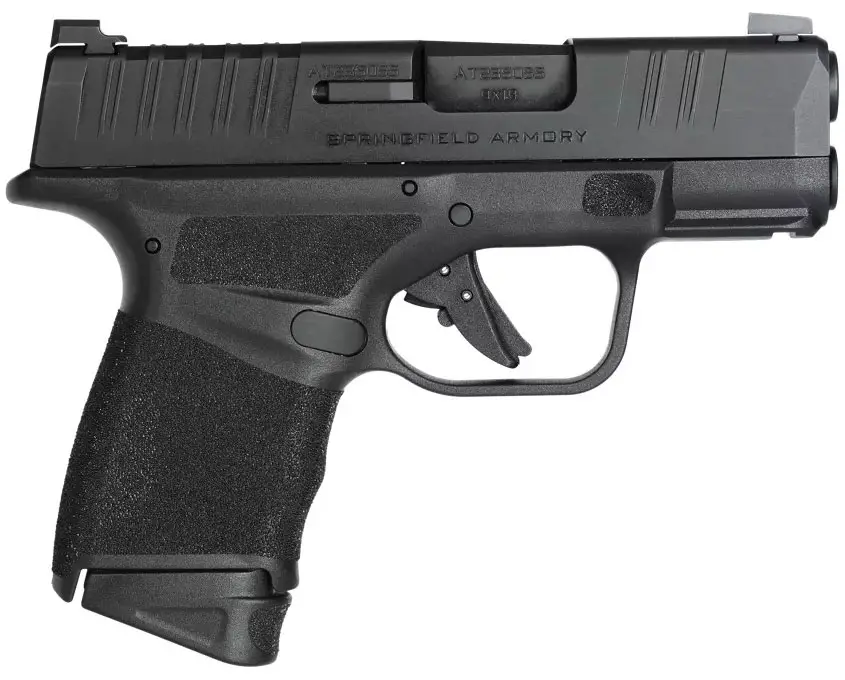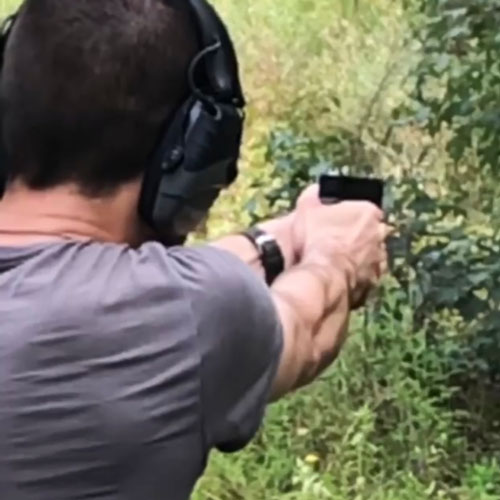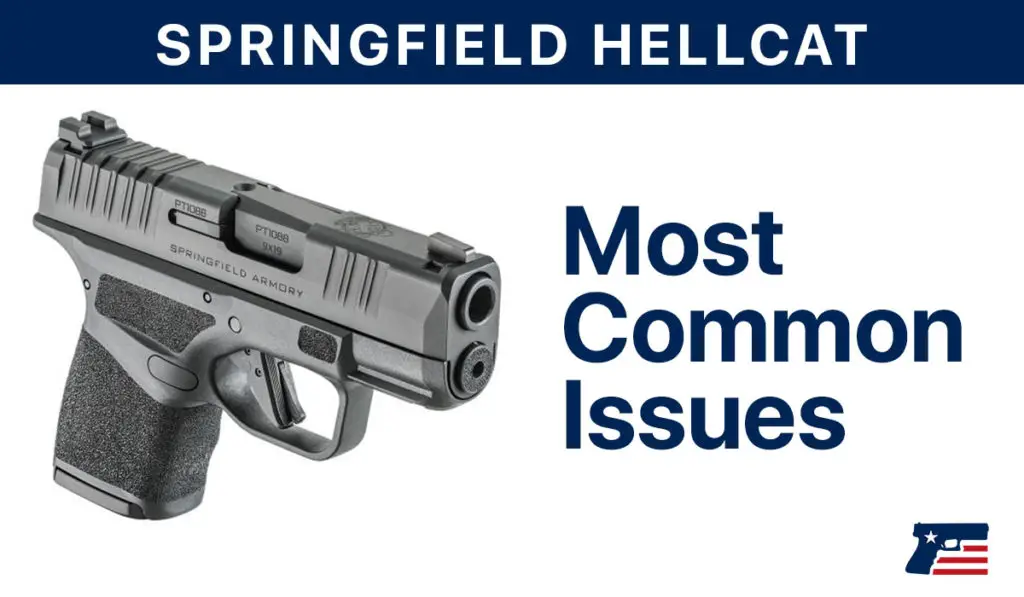The Springfield Hellcat is a popular concealed carry and self-defense pistol, prized for its small size, stopping power, and relatively large 11-round standard and 13-round extended magazine capacity. It is a great little 9mm pistol and we have several friends who are very happy with their Hellcats.
Every gun does have its little issues that can pop up from time to time and the Hellcat is no exception. The Hellcat has had several reports of common issues, namely defects in the trigger design. This isn’t necessarily a reflection on the entire gun as issues aren’t super frequent and seem to have been resolved with the latest released models. We just want to make sure consumers have all the available information on how to resolve any issues they may come across with their Hellcats.
Let’s take a closer look at the most common problems associated with the Springfield Hellcat and explore whether they’re universal issues or user errors.
Most Common Issues & Problems of the Springfield Hellcat

Touchy Trigger
Perhaps the most talked-about issue with the Springfield Hellcat is the trigger. Specifically, the Hellcat’s trigger has a tendency to jam through no real fault on the part of the shooter.
As several former or current Hellcat users can attest, a little bit of pressure on either side of the trigger may result in the trigger safety blade jamming. This may cause the trigger to lock or freeze, making the pistol impossible to shoot afterward.
Given that the pistol requires several pounds of pressure to fire fully, this is certainly cause for concern. However, you should note that more recent versions of the Springfield Hellcat seem to have done away with this error thanks to manufacturing adjustments. It’s also possible that Springfield simply changed the size of the trigger blade a little bit.
In any case, older models of the Springfield Hellcat may still have this or other trigger issues. So you should read reviews for the model in question before buying, or you should take the Hellcat to the range for a couple of test shots before putting all your money down on the weapon.
When trying out a new Springfield Hellcat, feather the trigger with your finger on either side to see if it freezes up or if it functions as expected.
Reliability Issues
Some Hellcat shooters have also reported reliability problems with the pistol. Of course, opinions on this point vary wildly – some shooters have fired thousands of rounds with their Springfield Hellcats and haven’t had any issues, while others have fired only a few hundred rounds and have seen the pistol degrade in accuracy and quality.
Ultimately, you may just chalk this purported problem up to a “your mileage may vary” issue. No matter the manufacturer, some pistols are duds or come with serious defects that prevent them from lasting or performing as long as they should. The Springfield Hellcat is no different in this regard.
Magazine Feeding Problems
Some Springfield Hellcat owners have discovered problems with the magazines used for this firearm. Of course, magazine problems are often contingent on the size of the cartridges and the magazine manufacturers, so it’s tough to say whether the problem is truly with the Hellcat or with individual magazines.
For instance, some shooters have reported issues when firing Federal American Eagle 147-grain cartridges. They also had issues with 115-grain cartridges from the same brand. These cartridges were round nose and each magazine had a 13-round capacity.
The problem seems to be that some Hellcat magazines don’t feed new cartridges into the firing chamber, resulting in a jam or a delay in follow-up shots. But again, it’s difficult to determine whether the problem is really with the Springfield Hellcat or if it’s an issue with a bad magazine (for example, magazines can easily become damaged beyond use if they are dropped even once).
To avoid this problem, make sure that your Springfield Hellcat is thoroughly oiled and maintained before taking it to the field or a firing range. Check each magazine before slotting it into place. That way, you can rule out any issues with the firearm itself if you encounter a feeding issue like other shooters did.
Uncomfortable to Shoot
Other Springfield Hellcat owners have stated that the firearm is simply a little uncomfortable to shoot, though this is ultimately a point of personal preference. As a micro-compact pistol, the Hellcat has a short grip and requires your hands to clench together to carry it properly.
Thanks to its caliber and the length of its barrel, the Hellcat is known to have a snappy recoil. Each trigger pull will result in the barrel jerking upward quickly, requiring quick target reacquisition on your part.
Generally, micro-compact pistols are snappy overall, and the Hellcat is no exception. Still, some shooters find the Hellcat to be too uncomfortable to use regularly or to replace their other concealed carry pistols. The trigger, as noted before, is far from the most responsive as well, and it may have some reliability issues depending on the model you purchase.
Analysis of the Hellcat Problems
Ultimately, the Springfield Hellcat is a decent if not incredible micro-compact pistol, ideally used for concealed carry self-defense or target shooting purposes. As a 9mm weapon, it features a 3-inch, hammer-forged steel barrel, and billet-machined slide ready for optics and attachments, plus built-in tritium lamp sights at the front.
While it does use a dual captive recoil spring with a full-length guide rod to control recoil, many shooters find the recoil to be a bit harsher than expected.
It seems that the majority of the reported issues for the Springfield Hellcat are due to individual experiences or slight manufacturing defects. There has been no official recall from Springfield regarding issues like the trigger or magazine feeding system, so these reported problems may ultimately be down to untestable flaws or fluke manufacturing mistakes.
Summary
Like all micro-compact pistols, the Hellcat has its share of fans and detractors. But fortunately, it looks like more recent Hellcat pistols come without the above-mentioned trigger problems. All other issues don’t appear to be inherent to the Hellcat itself.
In that case, feel free to purchase one of these pistols yourself or to give it a try if one of your buddies has already bought it. Take it for a test spin on the shooting range to see if you like the recoil or if the pistol is comfortable to hold.
As we said at the beginning, Hellcats are great guns and we aren’t discouraging anybody from purchasing one. Every firearm has its own unique set of issues you might run into along the way.

Growing up, John loved learning about the components of firearms and what makes them work, which still intrigues him to this day. He’s a very outdoorsy person, and he loves fishing, hunting, and skeet shooting. He is a firm believer in the Second Amendment and the right to bear arms.


So what can be done for the early model Hellcats with the trigger issues?
buy a aftermarket trigger
Nice firearm…with one problem. The slide release, along with being small and sharp, is VERY hard to move down. A thumb generally will NOT do it. Often, a right hander must use the left thumb to push down. It is either a too strong spring, the lock should be tapered, or too deep a cut in the slide. BUT….I noticed that it is very hard to release the slide when the mag is empty. but easier when a shell is in it. Inspection shows what when the mag is empty, the top left shoulder or the plastic in the mag, pushes up on the release spring/arm. With no mag/or the mag dropped 1/8 “, or a mag with a shell (the shell lowers the shoulder off of the spring) there is little pressure and the slide can be easily released with the right thumb. To solve this, I took one of my mags and filed/cut some of the shoulder down so there is less pressure on the release. Made a huge difference. I will have to do more mags.